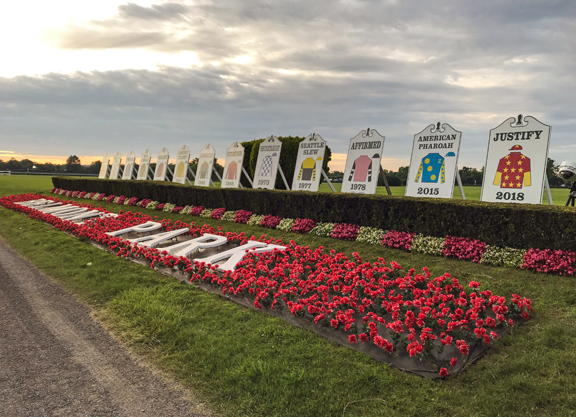By Christina Bossinakis
The American Triple Crown is among a never-ending string of sporting fixtures that have been upended as a result of the current coronavirus pandemic. Churchill Downs addressed the issue first, announcing that the 2020 renewal of the GI Kentucky Derby will be presented Sept. 5, while the Maryland Jockey Club followed, announcing the GI Preakness S. would also be rescheduled, although an official date has yet to be announced for the Triple Crown's second jewel despite reports of an October running. NYRA has yet to confirm a date for the GI Belmont S., originally slated for June 6.
And as the current environment of uncertainty and upheaval continues not only throughout all of sport, but on a worldwide stage, the altering of the long familiar incarnations of the Classics has proven unsettling and, in many cases, unwelcome, to most. However, a look back over the past two centuries in American racing details a long line of dynamic and at times momentous changes facing the three jewels through their storied histories.
The Kentucky Derby
The Kentucky Derby holds two distinctions over the other jewels of the Triple Crown–it has been run continuously since Aristides won the inaugural edition on May 17, 1875 and it has always been contested at its current home of Churchill Downs in Louisville, Kentucky. Modeled after England's Epsom Derby, the American version was contested at 1 1/2 miles beginning in its first year through 1895, before cutting back to its present day distance of 1 1/4 miles in 1896.
The race's running dates also varied greatly in its early history. From 1875 through 1931, the race was contested from as early as Apr. 29 in 1901 to as late as May 23 in 1883. Left to the discretion of the governing racing body of the era, the Derby followed the Preakness on seven occasions during the 1920s alone (from 1923-29), with a pair of seasons seeing the two jewels contested on the same day.
In 1945, the occurrence of World War II precipitated a government ban of all horse racing in January which threatened to have the event's 70-year-run come to an end, however, VE Day ('Victory in Europe Day', May 8) saved the allies, and the Derby, which was reinstated June 9. Won by Hoop Jr. that year, the Derby–which had not been restricted to a weekend (Saturday or Sunday) earlier in its history–would be earmarked for the first Saturday in May going forward.
The Preakness
A colt named Survivor triumphed in the inaugural edition of the Preakness at Pimlico in Baltimore, Maryland, two years prior to the Kentucky Derby in 1873. Contested at 1 1/2 miles through 1888, the race was cut back to 1 1/4 miles for the 1889 edition before returning to 1 1/2 miles in 1890, the year the race was transferred to Morris Park in Bronx, New York. With its age restriction lifted that season, the race-which was run on the Belmont S. undercard–was won by 5-year-old Montague in what would be the only occasion the Preakness was run not restricted to 3-year-olds.
Early on, the race struggled to gain widespread popularity, resulting in only a pair of entrants for the 1883-84 and 1889 renewals. As racing continued to wane, the Maryland Jockey Club discontinued all flat racing at Pimlico for the next three seasons (1891-93), and the Preakness along with it.
Returned to New York in 1894 to Coney Island's Gravesend Racetrack, the Preakness–carded at 1 mile 70 yards or 1 1/16 miles through 1908–returned to Pimlico in 1909 where it would remain. Run at a mile for the 1909-10 seasons, the fixture was extended to nine furlongs for the next 15 years before settling to its present day 1 3/16 miles in 1925. In total, the race has been run at seven different distances throughout its history.
In contemporary times, the Preakness has been a mainstay on the racing calendar, coming two weeks after the Kentucky Derby. However, that has not always been the case. After having been contested on several occasions prior to the Derby, the Preakness found itself as late as June four times, including in 1945 when Polynesian took it a week after the Derby. In fact, 1930 Triple Crown winner Gallant Fox won the Preakness (May 9) prior to winning that season's Kentucky Derby (May 17) before adding a win in the June 7 Belmont. With the Triple Crown beginning to pick up traction as a series through the '30s and early 40's, the Preakness fell into its customary spot on the calendar beginning in 1946.
The Belmont S.
Similar to the Kentucky Derby, the Belmont S. was the American Jockey Club's response to England's Epsom Derby. First run in 1867 (won by Ruthless), the Belmont was named after August Belmont Sr., who financed Jerome Park (built by Leonard Jerome), the site of the race through 1889. Relocated to Morris Park for the 1890 through 1904 renewals, the Belmont was finally moved to Belmont Park, which kicked off its inaugural season in 1905.
As racing flourished in the state at the turn of the century, an anti-gambling bill–the Hart-Agnew Law-was passed by the New York State Legislature on June 11, 1908. While influential owners, including August Belmont Jr. and Harry Payne Whitney, opposed the law, reform legislators continued to push for more restrictive legislation, including a law that made it possible for racetrack owners and its board of directors to be fined or imprisoned if found betting on the premises. The defeat of a 1911 amendment to limit the liability of owners and directors resulted in the closure of every racetrack in the state. Consequently, the Thoroughbred industry collapsed, which resulted in an exodus of trainers and horses overseas, in addition to the cancellation of the Belmont S. in 1911 and 1912. The resumption of racing in 1913 allowed for the race to return to Belmont, where it remained until the reconstruction of Belmont Park (1963-68), prompting the race to be held at Aqueduct.
Like the other two jewels in the Triple Crown, the Belmont underwent a series of adjustments to its conditions, including race distance, through its early history. Contested at Epsom's Classic distance from 1874 through 1889, the race varied from 1 mile 5/8 (1867-1873) down to nine furlongs (1893-94) before returning to its present-day 1 1/2-mile distance in 1926. Additionally, Belmont Park started off as a right-handed course in 1905, allowing the fixture to be contested in European fashion prior to the oval's adopting America's new counter-clockwise style in 1921.
The oldest jewel in the American Triple Crown, the Belmont also found itself at varying spots on the calendar throughout the years, and was typically scheduled in late May through early June early in its 151-year history. The one notable exception is 1895, when it almost wasn't run because of new laws banning bookmaking in New York. But despite the near miss, the race was allowed to be rescheduled for Nov. 2.
Triple Crown Trail
Through the first five decades of their inception, each of the three Triple Crown races faced their fair share of challenges, an ebb and flow of fortunes. Innovation and renewal were punctuated by periods of dissent and opposition, war and depression. While the series began to fall into an increasingly recognizable pattern on the calendar with the ensuing years, it wasn't until the 1920s that it actually started to be referred to as the Triple Crown. The Daily Racing Form's Charles Hatton is generally credited with solidifying the term in 1930, the year Belair Stud's Gallant Fox completed the series and it continued to take its present-day shape through the next two decades. In 1950, the Thoroughbred Racing Association commissioned an official trophy-crafted by Cartier–for the three-race series and it presented for the first time to 1948 Triple Crown hero Citation at that year's TRA's annual awards dinner in New York and in each subsequent year, a retroactive trophy was awarded, in reverse order, to the eight horses who completed the trifecta prior to 1948.
TC 2020 or Bust
While much debate has ensued whether the Classics will or should be contested in this season and if they are run, how they should be classified for posterity, it remains clear that time has proven to be the greatest equalizer. Approximately half of the Triple Crown winners are credited with completing the series before it was even considered the 'Triple Crown'. In the past, race dates and conditions varied–significantly at times–from the contemporary standard. So, given those early variations in all three of the Classics–spanning the better part of six decades–does that diminish or somehow alter the achievements of the earliest winners of the individual races or the horses who have managed to garner Triple Crown glory? It is often said that desperate times call for desperate measures, and in the year of the coronavirus, that appears to resonate even more forcefully. And despite any sweeping change the three Classics may face in 2020, this appears to be yet another step in the historical evolution of the Triple Crown.
Not a subscriber? Click here to sign up for the daily PDF or alerts.






